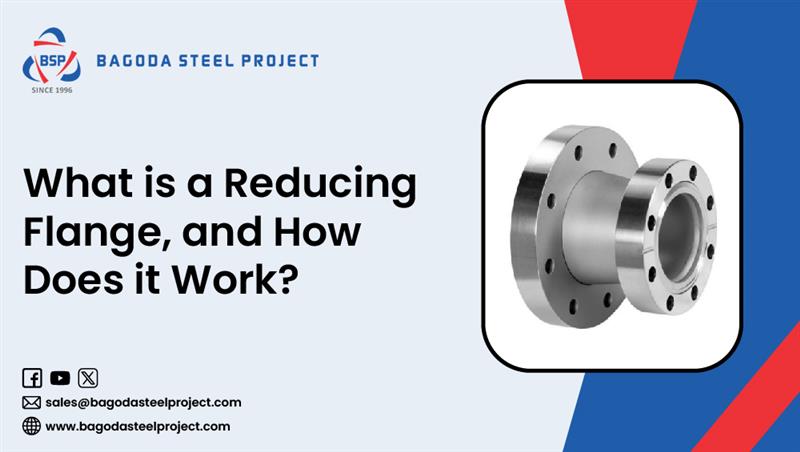What is a Reducing Flange, and How Does it Work?

What is a Reducing Flange, and How Does it Work?
Efficiency and Versatility are essential concepts in the world of piping systems. Many engineers and designers often find it difficult to connect pipes of different sizes within a complex pipeline. A key component that plays a major role is the Reducing Flange. So, whether it ishigh-pressure applications in oil and gas, or working on water treatment plants that you are dealing with, reducing flanges are consistently used for safe and seamless transitions between pipes of different sizes.
We at Bagoda Steel Project present to you this weblog that will help you understand everything that you need to know about a Reducing Flange and also show you how you choose the right Reducing Flange manufacturer which offers your business precisely what it needs.
What is a Reducing Flange?
Typically, a Reducing Flange is a piping component that is designed specifically to connect pipes of different diameters. It permits the change in pipe size without the need of using a separate reducer fitting and flange. TheReducing Flange is made by fusing together the features of a flange and a reducer into one compact unit, which allows saving of time and simplification of installation.
Unlike a flange that is standard, which connect pipes of the same size, reducing flanges are designed using two different diameters. It is one side that matches the larger pipe. Meanwhile, the smaller pipe connects with the other flange. Usually, this type of flange is perfect for piping systems that do not require space nor in those where alignments issues occur.
More importantly, you need to know that quality reducing flanges can be purchased at affordable prices from a top Reducing Flange manufacturer in India like Bagoda Steel Project
How Does a Reducing Flange Work?
Are you wondering how a Reducing Flange functions? The answer to this question that may pop up in your mind, is that it serves by maintaining a secure and leak-proof connection between two pipes having different sizes.
Besides, a gasket is used between the flanges to ensure a tight seal. Meanwhile, the internal bore of the reducing flange slowly makes a transition from the larger to the smaller diameter. This helps in minimizing turbulence and pressure drops.
Typically, proves to be useful specifically in systems transporting gases or liquids at high velocities. These are essentially components in which abrupt changes in diameter could lead to energy loss or system damage. It is such a scenario that reducing flanges help maintain flow efficiency and system integrity.
Types of Reducing Flanges:
In terms of the types of a Reducing Flange there are several available in the market. We at Bagoda Steel Project provide you with some useful insights about a few of them.
- Weld Neck Reducing Flange:
These are flanges that are designed specifically for system that involve the use of
high-pressure. Usually, they are welded to the pipe. Their unique selling point or USP
is that they offer excellent strength and leak resistance. A major reason they are ideally
suited for critical applications like oil and gas pipelines.
- Slip-On Reducing Flange:
Usually, these flanges are slipped over the pipe and then welded in place. They are
easier to install as compared to weld neck flanges and used in low-pressure
applications.
- Threaded Reducing Flange:
They are a type of flange that has internal threads and are screwed onto the pipe.
Mainly used for smaller pipe sizes and systems where welding is not an applicable
option.
- Socket Weld Reducing Flange:
Generally used only for smaller high-pressure piping systems. It is in the socket of this
type of flange that pipe is inserted and the welded.
- Blind Reducing Flange:
It consists of a reduced center opening which is used to close the end of a pipe, and
make allowance for future connections to smaller pipes.
Applications of Reducing Flanges:
A Reducing Flange is supplied for a wide range of industries for various purposes. They are as follows:
- Oil and Gas Industry: Mainly for connecting varied pipelines of different sizes in drilling rigs, refineries, and distribution systems.
- Chemical Processing Plants: For limited space and where precise control over flow rates is required.
- Water Treatment Facilities: Used to connect different pipes within the filtration and distribution systems
- Power Plants: Helps in accommodating transitions in steam and cooling water systems.
- HVAC Systems: Useful in joining ducts or pipes of different diameters in heating and cooling networks.
Benefits of Using a Reducing Flange:
There are several advantages to using a Reducing Flange. They are as given below:
- Space-Saving Design
- Enhancement of Flow Dynamics
- Ease of Installation
- Cost-Effective
- Versatile
Choosing the Right Reducing Flange Manufacturer:
Usually, while selecting the appropriate Reducing Flange manufacturer to provide for your business there are a few factors that you need to consider before hiring:
- Material Quality delivered
- Check for Manufacturing Standards
- Customization options
- Testing and Certification validation
- Global Supply Network availability
A Reducing Flange is, in its essence, is not just a connector but an important component in optimizing the performance and reliability of piping systems. So, whether you are upgrading an existing piping system or building a new one, you must hire a leading Reducing Flange manufacturer in India like Bagoda Steel Project, and ensure that your piping systems run smoothly, safely, and efficiently.

